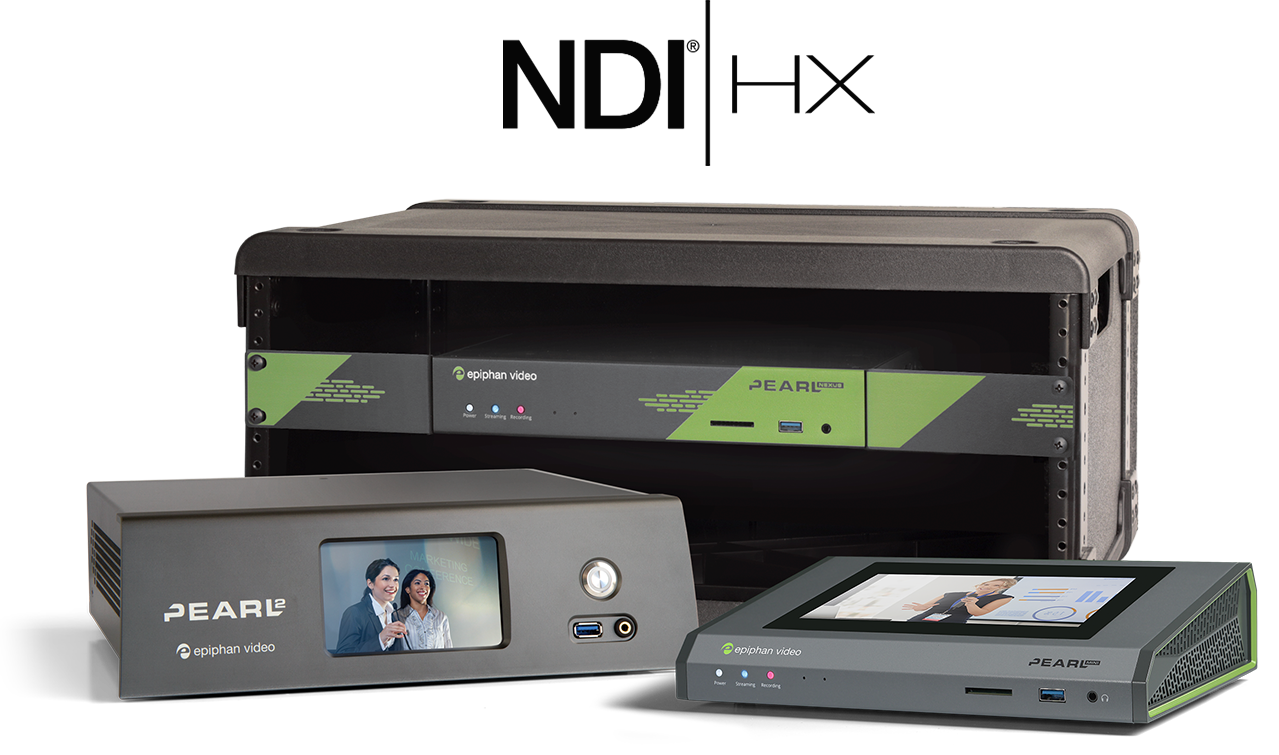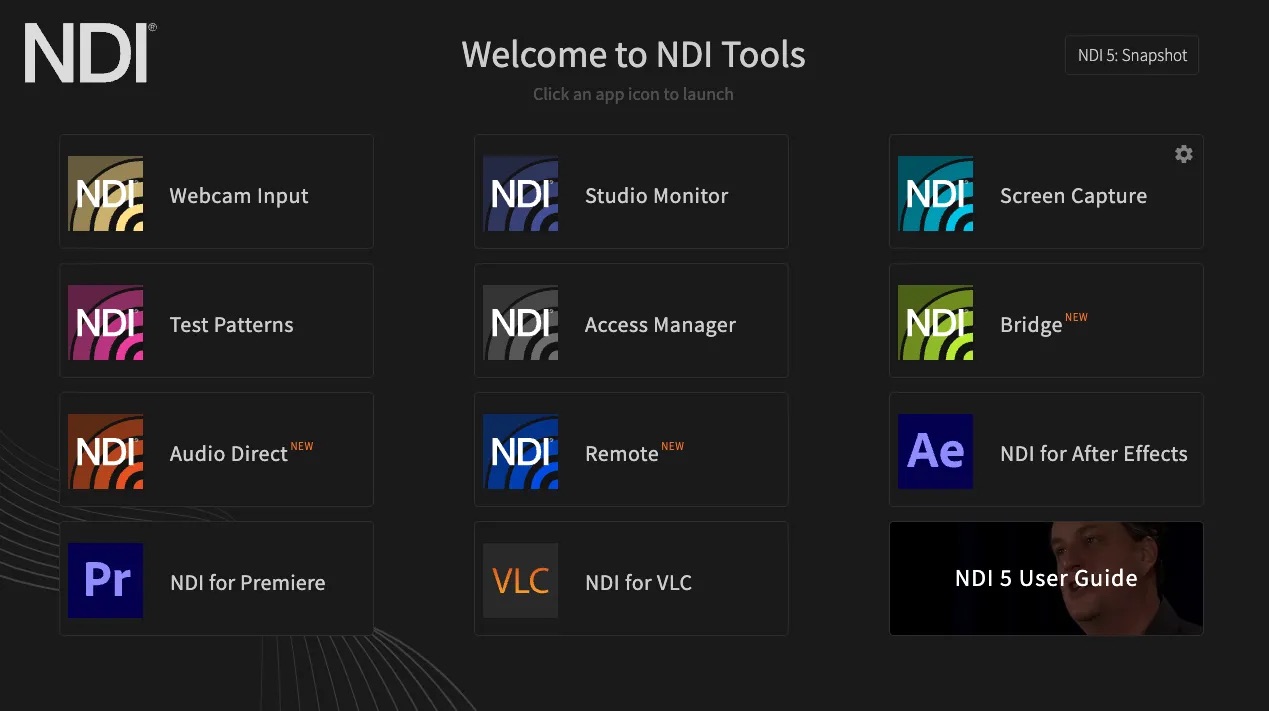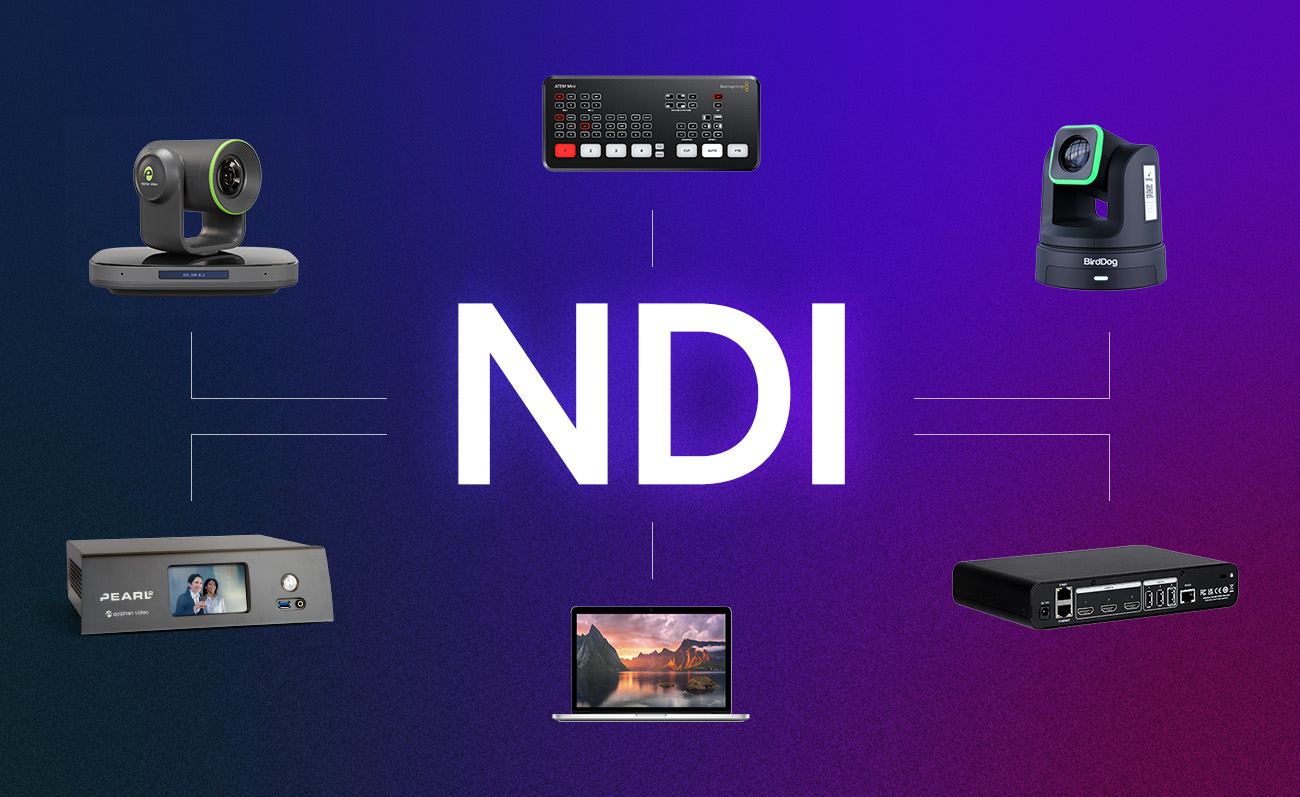The way we transmit video has changed dramatically in recent years. NDI streaming is one of the most important shifts driving professional streaming today. Developed by NewTek, NDI makes it possible to transmit high-quality video over standard IP networks in real time. For production teams, this means less reliance on bulky HDMI cables and SDI cables and more freedom to build flexible, scalable systems on existing network infrastructure.
In this guide, we’ll answer the question “what is NDI”, how it compares to traditional protocols like HDMI and SDI, and what you need to know to implement it in 2025.
What is NDI and why it’s revolutionizing video production
At its core, NDI (short for Network Device Interface) is a video-over-IP protocol that enables multiple video streams to travel across a local network with very low latency. Unlike legacy systems, where every camera or video source requires a direct cable to a switcher, NDI allows you to route and share sources across your IP networks.
The benefits are clear:
- High-quality video: NDI supports resolutions up to 4K and beyond.
- Seamless integration: It works on the same infrastructure already in place for most businesses and schools.
- Scalability: Adding new NDI sources is as simple as connecting them to the network.
For professional broadcast environments, this shift is as significant as the move from analog to digital.

Boost your NDI workflow with Pearl
Pearl Mini, Pearl-2, and Pearl Nexus are fully NDI-enabled, letting you transmit, record, and switch multiple high-quality video streams over your existing IP network.
NDI vs HDMI vs SDI
How does NDI compare with other standards?
- HDMI (High Definition Multimedia Interface): Great for short runs and consumer devices, but limited in distance. Once you need more than a few meters, signal quality drops.
- SDI (Serial Digital Interface): A workhorse of broadcast, designed for long cable runs and reliable video transmission. However, it requires specialized cabling and doesn’t integrate with IT networks.
- NDI: Uses the local network you already have. It supports live video routing and eliminates the need for separate video wiring.
In short, it’s not about “NDI vs HDMI” or “NDI vs SDI.” It’s about knowing when to use each. For example, HDMI, SDI, and NDI often coexist in hybrid systems: cameras connect via SDI, encoders output NDI, and displays still rely on HDMI.
| NDI | HDMI | SDI | |
|---|---|---|---|
| Primary Use | Professional streaming, IP-based workflows | Consumer electronics, short cable runs | Broadcast environments, long cable runs |
| Connection Type | IP networks (Ethernet, Wi-Fi) | Physical HDMI cables | Physical SDI cables |
| Distance Limitations | Unlimited on network (depends on infrastructure) | Typically up to 15–50 ft (5–15 m) | Up to 300 ft (90 m) for HD-SDI, longer with boosters |
| Scalability | Highly scalable, many NDI sources share the same local network | Limited, each device requires direct cabling | Moderate, each device requires dedicated wiring |
| Video Quality | High quality video, supports HD, 4K, 8K, HDR | High-definition video (up to 8K on newer versions) | High-definition video, robust in pro workflows |
| Latency | Low, near real time (network-dependent) | Very low (direct cable connection) | Very low (direct cable connection) |
| Infrastructure Needs | Uses existing network infrastructure | Requires dedicated HDMI cabling | Requires dedicated SDI cabling and routing gear |
| Flexibility | High – works with software, cloud, and hardware | Low – point-to-point only | Medium – reliable but not as flexible as IP |
| Professional Broadcast Use | Growing rapidly, ideal for hybrid IP workflows | Rare (mostly consumer-level) | Standard for traditional professional broadcast |
Step-by-step NDI setup guide
Getting started with NDI doesn’t have to be complicated. Here’s a quick NDI setup guide:
-
Prepare your network
Ensure your switch supports gigabit speeds (10GbE for larger productions). NDI is a high-bandwidth protocol, so network optimization matters.
-
Connect your NDI sources
Cameras, production switchers, or encoders that support NDI will appear on the network automatically. Use free NDI tools to discover, route, and test your sources.
-
Integrate with your workflow
Many professional streaming platforms and software tools now support NDI natively.
Within minutes, you’ll see your devices appear on the same network, ready to share video without direct cabling.

Bandwidth requirements and network optimization
Because NDI transmits high-quality, real-time video, it places demands on your network:
- Standard NDI requires about 125 Mbps for a 1080p60 stream.
- For larger setups with multiple streams, you may need 10GbE networking.
- NDI|HX, a compressed variant, lowers bandwidth to around 10–20 Mbps per stream (ideal when running dozens of feeds).
To avoid bottlenecks, segment production traffic or use managed switches with Quality of Service (QoS) enabled. This ensures smooth video transmission without affecting other business applications.
NDI-enabled equipment recommendations
In 2025, almost every major AV manufacturer offers NDI-enabled devices:
Cameras
PTZ cameras from Panasonic, Canon, and BirdDog make great NDI sources.
Use cases
- Education: Universities use NDI PTZ cameras to capture lectures in hybrid classrooms, where cameras can be remotely controlled without extra cabling.
- Corporate: Boardrooms deploy PTZs for town halls, making it easy to route multiple video streams into conferencing platforms.
Encoders/decoders
Hardware like Epiphan Pearl systems can transmit video as NDI while also handling recording and streaming.
Use cases
- Houses of worship: Churches rely on Pearl to send live video feeds across their local network, integrating smoothly with projection systems and online streaming platforms.
- Enterprises: Training facilities use Pearl to simplify recording and video transmission for both in-room displays and remote audiences.

Software tools
vMix, OBS, and Zoom now support direct NDI inputs.
Use cases
- Live events: Production teams at concerts or sports venues pull in dozens of NDI sources—cameras, graphics, and laptops—over the network to create professional-grade mixes.
- Broadcast studios: Producers use NDI-enabled software to bring in remote contributors, combine graphics, and output to traditional SDI cables when needed.
When choosing gear, consider whether you need professional broadcast reliability, support for mixed HDMI, SDI, and NDI, or the ability to scale with additional video streams.
Troubleshooting common NDI issues
Even the best networks run into hiccups. Common issues include:
- Dropped frames: Often a sign of insufficient bandwidth or unmanaged switches.
- Discovery problems: If a device doesn’t appear, check that all equipment is on the same subnet.
- Latency spikes: Caused by congested networks or daisy-chained switches.
The good news is that with proper planning and seamless integration, most NDI problems are easy to resolve.
Future of NDI technology and roadmap
Looking ahead, NDI continues to evolve. We’re seeing:
- Higher resolutions: Support for 8K and HDR live video.
- Cloud integration: Ability to send NDI streams beyond the local network, bridging remote production and on-premise workflows.
- AI-assisted optimization: Smarter compression and automatic bandwidth adjustments.
As adoption spreads, NDI is becoming the backbone of professional streaming. It’s a flexible, software-driven protocol that replaces the rigidity of traditional cabling.
Final thoughts
NDI streaming is no longer just an emerging trend. In 2025, it’s a mature, trusted way to move video across networks with the speed and quality professionals demand. Whether you’re comparing NDI vs HDMI, optimizing bandwidth, or building a hybrid workflow with HDMI, SDI, and NDI, the key takeaway is this: NDI makes video production simpler, more scalable, and more powerful than ever before.

